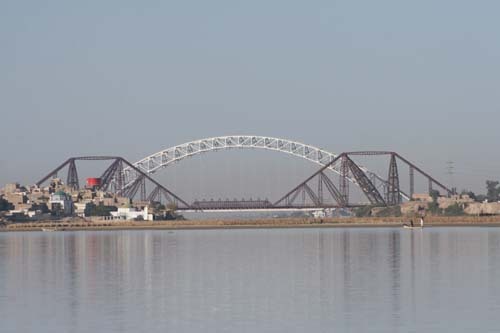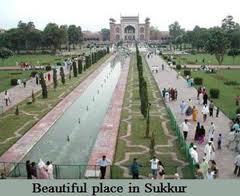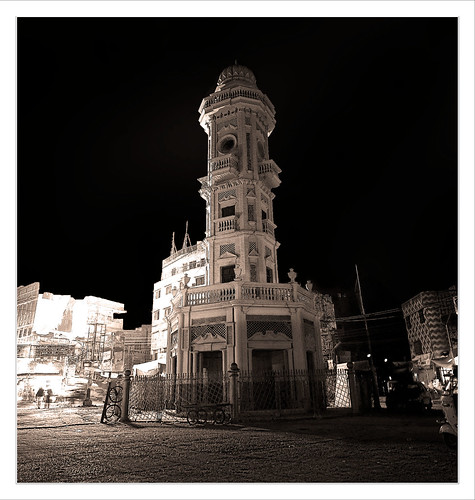Sukkur

Sukkur, or
Sakharu (Urdu: سكهّر), (Sindhi: سکر), formerly
Aror (Urdu: اروڑ
and
Bakar, is the third largest city of Sindh province, situated on the west bank of Indus River in Pakistan in Sukkur District. However, the word
Sakharu in Sindhi means "superior", which the spelling of the city's name
in Sindhi suggests is the origin of the name. Sukkur is nicknamed Darya Dino
, meaning the gift of river), as without the Indus the city would be a
desert. People of Sukkur speak Sindhi (72%), Urdu (15.5%), Punjabi (4%), Pashto (1.5%), Balochi (1%), and others 1%.

The Sukkur Barrage has
66 Gates. The Sukkur Barrage (formally called Lloyd Barrage),
built under the British Raj
on the Indus River, controls
one of the largest irrigation systems in the world. It was designed by Sir
Arnold Musto KCIE, and constructed under the overall direction of Sir Charlton Harrison, KCIE, as Chief
Engineer. Construction of the barrage was started in 1923 and completed in
January 1932. The 5,001 feet (1,524 m) long barrage is made of yellow stone and
steel and can water nearly 10 million acres (40,000 km2) of farmland
through its seven large canals. Some of the canals are larger than the Suez Canal.
In November 2004, the
government of Pakistan initiated a
rehabilitation project to revitalize its water storage capacity and distribution
efficiency. The project was completed in July 2005, (with less than the
allocated amount of Rs. 887 million). Experts believe that the rehabilitation of
the barrage has enhanced its efficiency for another 60 to 70 years

The district of Sukkur
(whose name is derived from its head quarter Sukkur city) covers an area of
5,165 square kilometres. Geographically it is spanned from 27°05' to 28°02'
north latitudes and from 68°47' to 69°43' east longitudes. The city of Sukkur is
located at an altitude of 220 feet (67 m) from sea level, having terrestrial
coordinates 68°52' east and 27°42' north. It is also the narrowest point of
the lower Indus course.
Sukkur district shares
its northern border with Shikarpur and the recently constituted Kashmore districts. Ghotki is located on the north-eastern side while Khairpur on the
south. The border with India lies further
east. Sukkur is also connected by road and by air with all major cities of
Pakistan.


Sukkur is a
hub of many small and large scale industries. Among important industries are
cotton textiles, cement, leather, tobacco, paint and varnish, pharmaceuticals,
agriculture implements, hand pumps, lock making, rice-husking, and sugar.
Small-scale cottage industries comprise hosiery, boat making, fishing
accessories, thread ball spooling, trunk making brass-wares, cutlery and
ceramics. Being an agricultural city, crops like rice, maize, cotton, tomatoes,
peas wheat, barley, gram and melons are sown here. Sukkur is famous world over,
for its delicious dates. Sukkur also holds a large number of riverine forest on
the course of Indus. These tropical forests are found within the protective
embankments on either side of Indus. During 1997-98 the total area under forests
was 510 km² which yielded 55,000 cubic feet (1600 m³) of timber and 27000
cubic feet (760 m³) of firewood besides other miner products.

Visit : Ghanta Ghar (Clock Tower) Bazaar should be your starting point where the
best part of bazaar is. Later you can visit Masoom Shah Jo Munaro (Menarat of
Masoom Shah) which is at a walking distance and if you have energy to climb 84
narrow steps there is a spectacular view of the River Indus and its two bridges.
Minaret was built by Historian and knight Masoom Shah in 18th century Later
drive to The Lloyd Barrage and Lansdowne bridge . At Lloyd barrage there is also
a small barrage Museum which explains the barrage system and some interesting
facts of the river Indus irrigation system. Near Lansdowne Bridge also visit the
"Sat Bahan Astan" A small graveyard from 15th to 17th century has beautifully
decorated tombs with blue Glazed tiles.


Board a house boat to give you a tour of the floating villages of Mohanas
(Fishermen) on the banks of river Indus. These people live on their house boats
and spend a very difficult life. See the colorful boats decorated with very
basic items and wood carving. Sometimes you can also get a glimpse of Indus
Dolphin during this ride. Indus dolphin is a unique animal found only in the
river Indus. They are blind due to the silt of the river and due to the flow of
the river they have adopted a continuous movement in them, against water. Visit
Sadh Belo a Hindu Pilgrimage area on the main island in river Indus, this was
the asthan (Places) of a Sadhu known as Bankhandi (Forest wonderer) in 1823 who
left the world in search of the od and meditated here. His meditation brought
mericle and goddess Durga appeared at the island. Keepinf this background in
mind the hindus pay a pilgramage to this island and consider it a sacred island.
You need a permission from the department of Oqaf to go there.

Lab-e-Mehran is famous garden in Sukkur, situated on Bandar Road, adjacent to the
Indus River, in Sindh Province, Pakistan. It was built with the cost of
12 crore rupees, and it is still
under development. There is a separate family area with a small hotel. There is
also boat riding facility. The garden is full of beautiful plants. This is main
visiting place in Sukkur city.Sometimes heaps of rubbish can also seen at
different places.




















